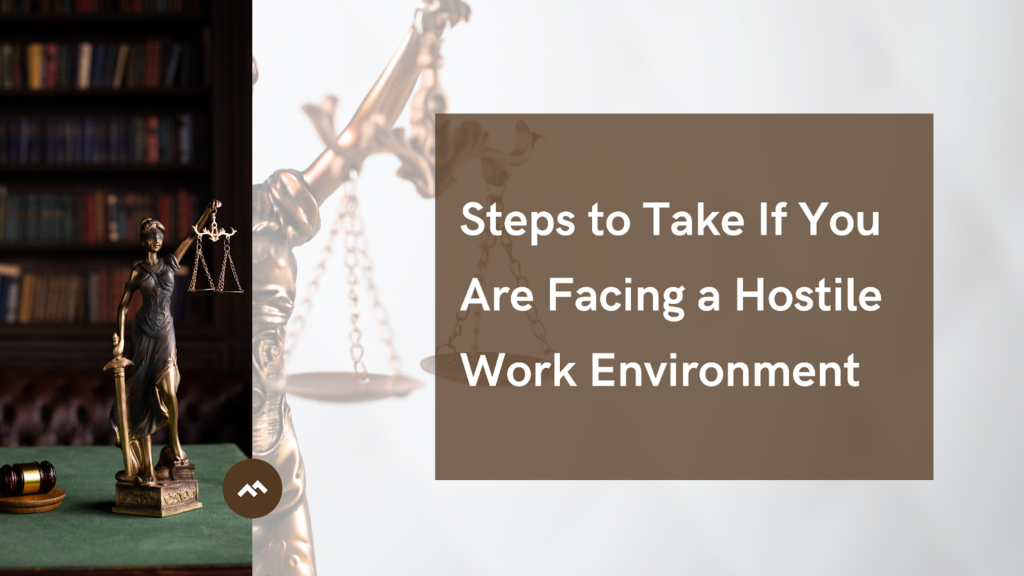Are you feeling unsafe or undervalued at work?
A hostile work environment can be a toxic place that negatively impacts your mental and physical health. If you are experiencing harassment, discrimination, or bullying, understand that you are not alone.
This article provides essential steps to help you navigate this challenging situation and reclaim your workplace.
Recognize the Signs of a Hostile Work Environment
Before taking action, it’s crucial to identify whether your workplace qualifies as hostile. A hostile work environment is characterized by pervasive, severe conduct that interferes with an employee’s ability to perform their job. Recognizing the signs early on can help you take the necessary steps to protect yourself.
Discriminatory Behavior: Discrimination based on protected characteristics such as race, gender, age, religion, or disability is a clear sign of a hostile work environment. This type of behavior can manifest in offensive remarks, unequal treatment in promotions, and exclusion from important meetings or projects. Such actions violate both ethical standards and legal protections.
Bullying and Intimidation: Workplace bullying can take many forms, including verbal abuse, constant criticism, and sabotage of work or reputation. These behaviors create a climate of fear and stress, making it difficult for employees to perform their duties effectively.
Unfair Policies and Practices: Hostility can also stem from unfair policies and practices, such as inconsistent application of rules and biased performance evaluations. These systemic issues create an environment where certain employees feel undervalued and marginalized.
Retaliation for Complaints: Retaliation against employees who report issues is a serious red flag. This includes demotions, pay cuts, and increased scrutiny, which discourage employees from speaking up and exacerbate the hostile environment.
Sexual Harassment: Unwanted sexual advances and comments, inappropriate touching, and the display of offensive sexual materials create a hostile environment that impacts an employee’s sense of safety and well-being.
Hostile Communication: Aggressive language, public humiliation, and passive-aggressive behavior contribute to a toxic atmosphere. Recognizing these patterns is essential for addressing hostility.
Isolation and Exclusion: Purposeful exclusion from team activities, withholding information, and social isolation can lead to feelings of alienation, negatively affecting an employee’s morale and performance.
Document Everything
Once you’ve identified hostile behavior, it’s crucial to start documenting incidents immediately. This step is vital for building a strong case and protecting yourself.
Record Incidents
Keep a detailed log of all hostile behaviors. Include the following details:
- Dates and times of incidents
- Descriptions of what occurred
- Names of any witnesses present
Save Evidence
Preserve any tangible evidence of hostility. This can include:
- Emails or text messages: Save any digital communication that demonstrates hostile behavior.
- Offensive materials: Keep copies of any offensive documents or images.
- Voice messages: Record and save any threatening or abusive voice messages (if legal in your state).
Organizational Tips
Use a dedicated notebook or digital document to maintain your records. Organizing your documentation systematically will be invaluable if you need to present your case later. Detailed records and evidence provide a clear picture of the hostile environment, strengthening your position when addressing the issue of legal authorities.
In a bustling city like Los Angeles, workplace dynamics can be intense, and hostile behaviors might not always be promptly addressed. The diverse and competitive job market can sometimes lead to overlooked or mishandled workplace grievances. If you find that internal measures are insufficient, consulting a hostile work environment lawyer Los Angeles can be a crucial step in understanding your legal rights and pursuing necessary actions to safeguard your workplace well-being. Legal professionals in Los Angeles are well-versed in local labor laws and can provide tailored advice to help you navigate your specific situation.
Review Company Policies
Understanding your company’s stance on workplace conduct is crucial. Review the employee handbook or policy manual, paying close attention to sections on discrimination, harassment, and reporting procedures.
Familiarize yourself with the steps required to file a formal complaint and any time limits for reporting incidents. Knowing your company’s policies can help you navigate the process more effectively and ensure that you follow the correct procedures.
Report the Behavior
With documentation in hand and an understanding of company policies, it’s time to report the hostile behavior.
Internal Reporting
Start by reporting to your immediate supervisor or HR department. Schedule a private meeting to discuss your concerns, and bring your documentation to support your claims. Clearly and concisely describe the hostile behavior, focusing on facts and providing evidence to support your statements. Internal reporting is often the first step in addressing workplace issues and can lead to swift resolution if handled appropriately.
Alternative Channels
If you’re uncomfortable with standard reporting channels, look for an ombudsman or designated neutral party within the organization. Some companies also offer anonymous reporting hotlines, which can provide a safer way to voice your concerns.
Additionally, reaching out to a trusted senior manager who can advocate on your behalf might be an effective alternative. These channels can help ensure your complaint is taken seriously while maintaining a degree of confidentiality.
Seek Support
Dealing with a hostile work environment can be emotionally draining. Don’t hesitate to seek support both within and outside the workplace.
Internal Allies
Confide in trusted colleagues who may have witnessed the behavior or have experienced similar issues. Their support can provide validation and help you feel less isolated. Seek advice from mentors within the organization, and connect with employee resource groups if available. Internal allies can offer practical advice and emotional support, helping you navigate the situation more effectively.
Professional Help
Consider seeking external support as well. Consult with a therapist or counselor to manage stress and emotional toll. Join support groups for individuals facing workplace issues, where you can share experiences and gain insights from others who have been in similar situations. Explore employee assistance programs offered by your company, which may provide counseling and other resources to help you cope.
Consult an Employment Attorney
If internal measures don’t resolve the issue, it may be time to seek legal advice. An experienced employment attorney can help you understand your rights under labor laws, assess the strength of your case, and guide you on potential legal actions. They can assist in evaluating evidence and identifying witnesses.
Potential legal outcomes to discuss with your attorney include:
- Compensation for emotional distress
- Recovery of lost wages
- Reinstatement or job transfer
Understanding your legal options empowers you to make informed decisions and protect your rights and well-being.
File a Complaint with External Agencies
If internal processes fail, consider filing a complaint with government agencies.
EEOC Complaint
The Equal Employment Opportunity Commission (EEOC) handles workplace discrimination complaints. File a charge within 180 days of the incident (300 days in some states), providing detailed information about the hostile behavior. Cooperate with the EEOC investigation, as their findings can significantly impact your case and potential remedies.
State Agencies
Many states have their own fair employment agencies with specific procedures and timelines. Research your state’s agency, understand the differences in procedures, and consider filing with both state and federal agencies for broader protection. These agencies can offer additional avenues for resolution and ensure your complaint is thoroughly investigated.
Prepare for Potential Outcomes
As you navigate this process, be ready for various outcomes. Positive resolutions might include changes in workplace policies, disciplinary action against offenders, and financial compensation, fostering a safer work environment. If initial complaints are not satisfactorily resolved, understand the appeals process for agency decisions and consider pursuing a lawsuit if necessary.
Be prepared for potential retaliation, which is illegal but may still occur. Staying informed and proactive can help you manage these challenges and work toward a fair resolution, ensuring your rights and well-being are protected.
Foster a Healthier Work Environment
Regardless of the outcome, you can play a role in improving workplace culture. Advocate for regular training on workplace respect and lead by example in your interactions. Speak up against inappropriate behavior and encourage open communication.
Support initiatives that promote diversity and inclusion, and participate in feedback sessions to drive positive change. By fostering a culture of respect and inclusion, you can help prevent future instances of hostility and create a more supportive and positive workplace for everyone.
Comparison: Internal vs. External Reporting
When facing a hostile work environment, it’s essential to understand the differences between internal and external reporting. Internal reporting often leads to faster resolutions, as the company can address issues directly. However, confidentiality may be limited, and there’s a higher risk of retaliation.
On the other hand, external reporting typically offers more protected confidentiality and legal safeguards against retaliation, though the process can be lengthy and less within your control.
| Aspect | Internal Reporting | External Reporting |
| Speed of Resolution | Often faster, as the company can address issues directly. | Can be lengthy, as external agencies follow their investigation timelines. |
| Confidentiality | May be limited, depending on the organization’s policies. | Usually more protected, with legal safeguards against retaliation. |
| Control Over Process | More direct involvement, as you can follow up on the progress. | Less control, as the agency handles the investigation. |
| Potential for Retaliation | Higher risk, as reporting internally can strain immediate work relationships. | Lower risk, as external reporting is legally protected. |
| Cost | Generally free, as it’s handled within the organization. | May involve legal fees if pursuing further legal actions. |
| Impact on Work Relationship | Can strain relationships within your immediate work environment. | Less immediate impact on daily work, but can affect overall company policies. |
| Long-term Organizational Change | This can lead to internal policy changes and improvements. | This may result in mandated changes, creating a broader impact on company culture. |
Frequently Asked Questions
Can I remain anonymous when reporting a hostile work environment?
While some organizations offer anonymous reporting mechanisms, complete anonymity can be challenging to maintain during investigations. External agencies like the EEOC allow for confidential complaints, providing an additional layer of protection for those concerned about retaliation.
How long do I have to file a complaint?
Time limits vary, but generally, you should file with the EEOC within 180 days of the incident (300 days in some states). Internal company deadlines may differ, so check your employee handbook to ensure you meet all necessary timelines.
What if I face retaliation for reporting?
Retaliation for reporting workplace issues is illegal. Document any retaliatory actions and report them immediately to HR, your attorney, or the relevant government agency. Taking swift action can help protect your rights and hold offenders accountable.
Conclusion
Facing a hostile work environment is challenging, but recognizing the signs, documenting incidents, and taking appropriate action can help you address the situation effectively.
Remember to review company policies, seek support, consult an employment attorney if necessary, and consider both internal and external reporting options. By taking these steps, you can protect your well-being and work towards creating a healthier, more respectful workplace. Your rights and professional growth are worth defending.






